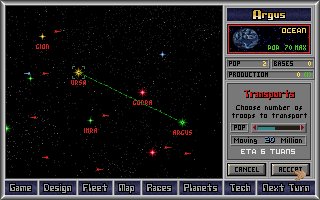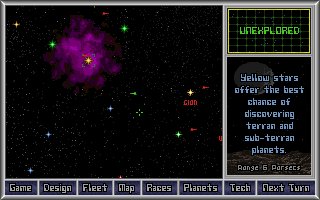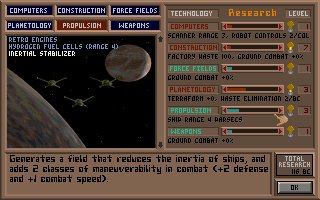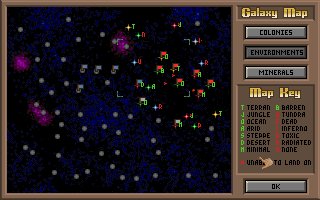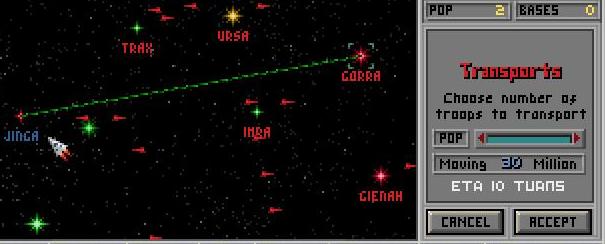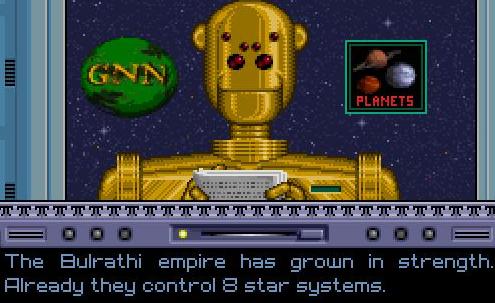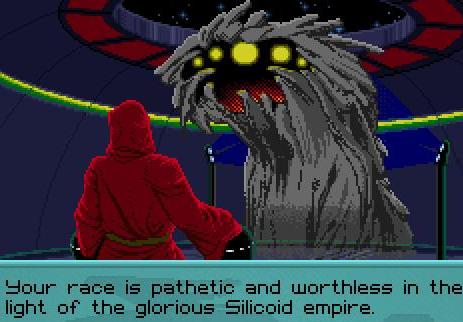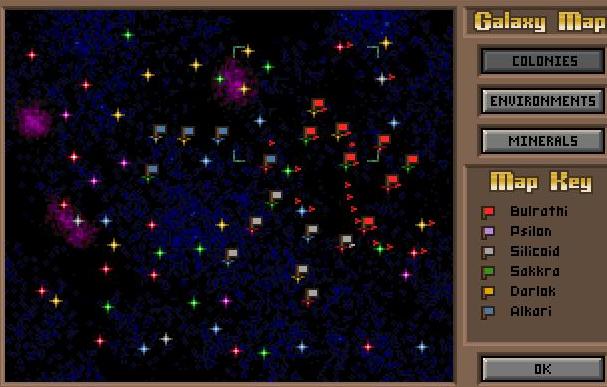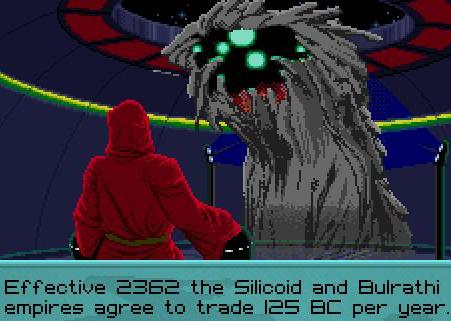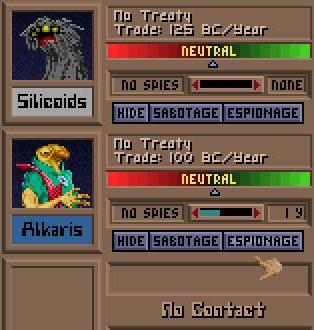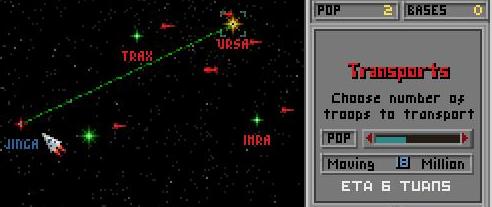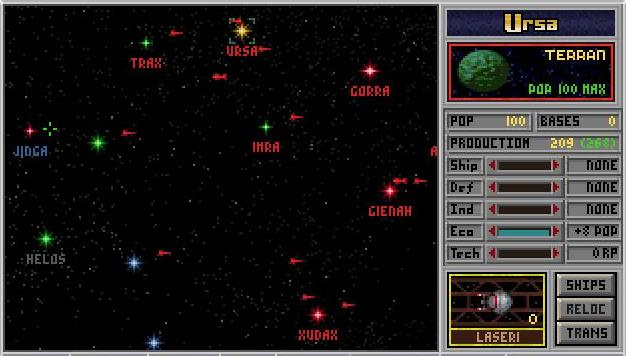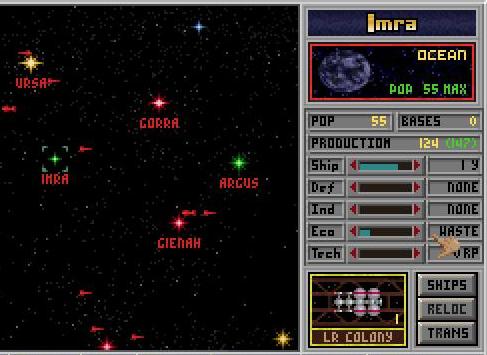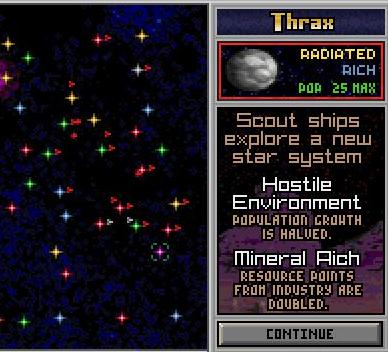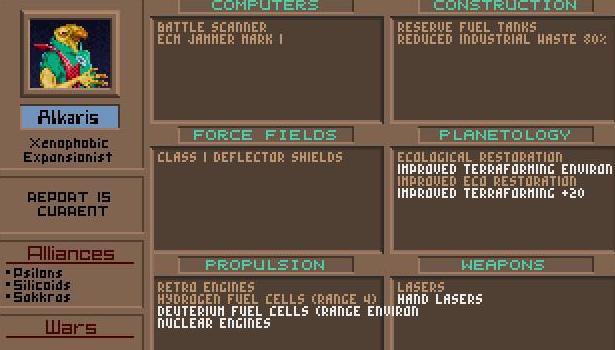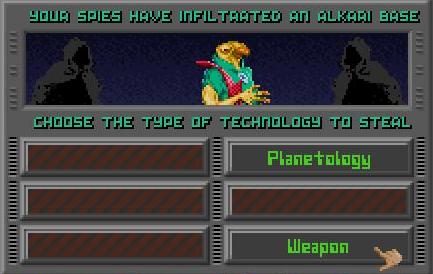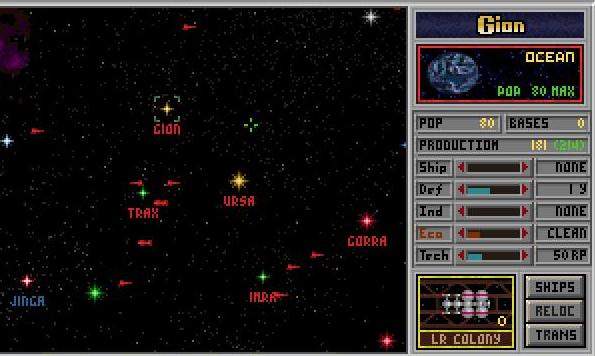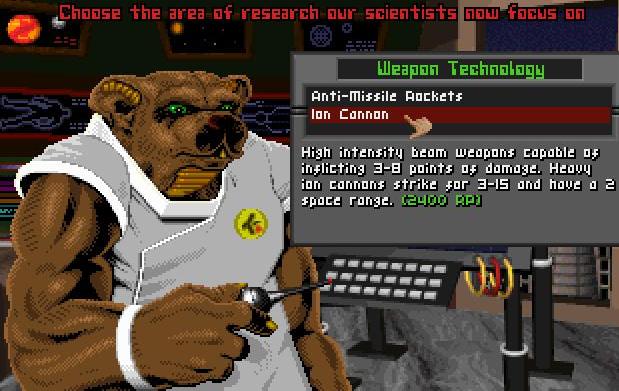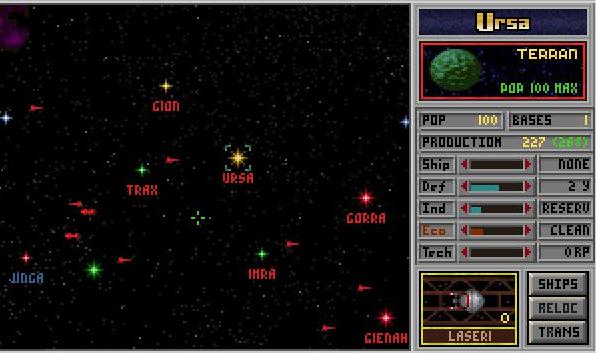Nice round, Jabah. Allow me to offer some commentary.
The transport relay is good work. That will put colonists on Imra one turn sooner.
"MM Ursa to keep it MAX" is solid but not ideal. Rather, that falls a little bit short of ideal, if the goal is to max per-turn production. The "Max" tag is "out of synch" with reality by one turn. It measures max for the CURRENT population, but does not, cannot factor population changes. Yet next turn's production will be based on NEXT TURN's population, so the ideal performance is to "look ahead" to what the pop will be on the next turn, and have that many factories ready and waiting to be put to use. The Max reading doesn't factor pop growth, or any orders sending transports outgoing or bringing some incoming.
Note that in my comments following Charis's turn, I suggesting ignoring the "Max" reading altogether and pushing way way past it. At one point in my approximation, I showed 84 pop but 190 factories. Those 84 pop could only use 168 factories, but I had sped on to build factories asap. 22 factories sat idle that turn, and I did not see this as a problem. I always had factories ready to go for newly grown or immigated population points.
Let me put this another way. If it doesn't say Max at ALL times in the Industrial slider, then your current factory count is short of ideal and at least some population are unemployed. You are missing out on at least a small amount of production that your population could have supported. Instead you want it to say Max even when you would be building a single factory, because that means you are CURRENTLY at max. That make sense? Anybody not following this point?
Some facts to consider:
* There is no cost for idle factories. No waste, no maintenance.
* There is no reason to avoid building idle factories.
* There is a reason to avoid even minimal unemployment, if you can avoid that.
* If you use the changeover in the industrial slider from numbers to "Max" reading, you are targeting next year's factory total to this year's population. If you could target instead to next year's population, THEN you're at ideal performance.
* You will have to build the factories eventually. Why go through the micromanagement work of matching ideal ratio of factories to population? Max out the factories -- it costs you nothing -- then shift to other tasks. NO PRODUCTION GETS WASTED. You simply get the factory part out of the way up front and delay the expenditure of a few BC into whatever else you would be doing. If those few BC are not decisive (in a few cases they might be) then they won't really be missed, only delayed at no real penalty, so save yourself a bunch of makework that won't gain you anything.
See? Even when it comes to the micromanagement aspects, this game is a masterpiece. There's plenty of micro available for efficiency nuts, but a lot of it REALLY DOES NOT MAKE AN ACTUAL DIFFERENCE when you look closely, so learning when to bother and when not to bother can save you time and energy and let you remain focused on the strategics, not the minutiae.
The homeworld is a bit of a unique case. It gets such a massive head start on factory construction compared to all other colonies, that it may warrant bringing some colonists home at the tail end of its ripening to speed the arrival at max output. That is because there are a bunch of unemployed on the second colony, who can be put to better use. For all other colonies, this won't be the case on most maps. New colonies will be founded fairly close together and will "grow up together", in a way that doesn't lend to shuffling population around in search of significant benefits.
Jabah did bring colonists home from Gion, and he did not miss out on much production, so he did a very fine job. Maybe 70-80 total gross BC missed and after cleanup costs, 40-45 net BC not earned. Figure 4 BC gross lost for each pop who went unemployed for one turn (each employed factory put outs 2 BC, times two for each pop point). Each newly grown pop point, or each arriving immigrant, only went one turn without jobs, because Jabah would build factories for them after that one turn. So... overall, like I said, only about 40 BC net that was missed. That won't even make one turn's difference on a colony ship, and we're not talking about spending that is applied to a key point in a planet's growth curve, so no "penalties and interest".
My spending 9BC to check the three tech fields cost us MUCH more than this, to give you a comparison.
Now the homeworld is fully ramped up and potential choices for our civ have hit that critical point where strategy will decide our fate, where the choices leave the realm of "no brainer" and enter into greater complexity. I find myself hoping that Team Two scored a high quality tech out of the artifacts world, so that our results will be more closely comparable, but that's out of our hands.
We've had no word yet about AI scouts showing up at planets to the southwest. We know that the Sakkra are not a threat to those systems. In that case, if I were Up Now, I would follow the pink chain and grab everything there without prioritizing any research. That would form our back line core and open additional scouting to the south, where either there are virgin lands, or a neighbor. In either case, expanding our prospects.
We could let Gion ramp up to 80-100 factories, enough to keep 40-50 pop full employed while we KEEP that colony around that level and use it to do research at full rate and use its pop growth to feed a steady stream of people to other colonies. And to that end, I would ignore Charis's most excellent insights into "maxing empire wide growth rates" and keep Gion right AT 50% full, because Gion has a 5+ parsec distance to everything to the south, and the key element to supplying the most troops to the most number of new colonies is the SOURCE RATE, RIGHT NOW, not the total growth rate, which is harmed significantly by having too many transports in flight from Gion to colonies. The bird in the hand of colonists at Gion NOW beats the two in the bush of sending too many from Gion up front and having them not growing while in transit. Especially when Gion is also in good position to feed colonies on the white path.
Now as for research, when Jabah HALTED research, the portion that Charis had already invested began to decay. Research points are LOST if research is completely halted in any given field. We did not have many invested, so this may even have been the right choice to make, but it would NOT have been wise if a heavy investment had been made. We could be losing dozens of RP to decay, and later in the game could lose hundreds or even thousands of RP if any such research halt is ordered. Even a minimal trickle prevents decay.
MOO1 rewards steady research efforts over erratic and dramatic micromanagement shifts. Not only is there a decay factor for halting research. There is also a bonus factor for steady research, which ramps up as a steady amount of BC are invested into each field. That's why Zed recommends choosing the ratio you want for emphasizing fields and "leaving well enough alone" once you do. I tend to do a little bit more active tech management, but even that is with only about 40% of the research budget, keeping a steady 10% (x6) into each field as a minimum baseline, so I'm always gaining the max bonus for steadiness on at least 60% of my research effort. The other 40%, if concentrated into one field, would see a single field getting as much as half of all my current research investment, and it too will enjoy some steadiness bonus if I'm not flinging it around too often.
I still recommend a 50-50 split on researching Barren and Range 4 simultaneously (they cost about the same) followed by a 50-50 split on both cleanup techs (which, again, cost about the same). That seems like a clear winner to me on research strategy. The strategic choice was not so much how much to emphasize this research field over that one, but instead whether or not to keep homeworld ONLY on shipbuilding, to follow the pink line ASAP, or to put more to tech sliders up front and learn the techs to open the white and orange paths to settle those BEFORE the pink path worlds. Well, the scouting on Charis's turn answers these questions. There's an artifacts planet on the pink path, and ALL planets on that path are nonhostile. Everything on the orange path is lost to us because of hostile environments and Sakkra presence. No major threat has emerged to the white path, so let's take the path of least resistance (literally) and go pink first.
That would be my analysis. Players who are up need not follow these suggestions. Other choices are available.
- Sirian
The transport relay is good work. That will put colonists on Imra one turn sooner.
"MM Ursa to keep it MAX" is solid but not ideal. Rather, that falls a little bit short of ideal, if the goal is to max per-turn production. The "Max" tag is "out of synch" with reality by one turn. It measures max for the CURRENT population, but does not, cannot factor population changes. Yet next turn's production will be based on NEXT TURN's population, so the ideal performance is to "look ahead" to what the pop will be on the next turn, and have that many factories ready and waiting to be put to use. The Max reading doesn't factor pop growth, or any orders sending transports outgoing or bringing some incoming.
Note that in my comments following Charis's turn, I suggesting ignoring the "Max" reading altogether and pushing way way past it. At one point in my approximation, I showed 84 pop but 190 factories. Those 84 pop could only use 168 factories, but I had sped on to build factories asap. 22 factories sat idle that turn, and I did not see this as a problem. I always had factories ready to go for newly grown or immigated population points.
Let me put this another way. If it doesn't say Max at ALL times in the Industrial slider, then your current factory count is short of ideal and at least some population are unemployed. You are missing out on at least a small amount of production that your population could have supported. Instead you want it to say Max even when you would be building a single factory, because that means you are CURRENTLY at max. That make sense? Anybody not following this point?
Some facts to consider:
* There is no cost for idle factories. No waste, no maintenance.
* There is no reason to avoid building idle factories.
* There is a reason to avoid even minimal unemployment, if you can avoid that.
* If you use the changeover in the industrial slider from numbers to "Max" reading, you are targeting next year's factory total to this year's population. If you could target instead to next year's population, THEN you're at ideal performance.
* You will have to build the factories eventually. Why go through the micromanagement work of matching ideal ratio of factories to population? Max out the factories -- it costs you nothing -- then shift to other tasks. NO PRODUCTION GETS WASTED. You simply get the factory part out of the way up front and delay the expenditure of a few BC into whatever else you would be doing. If those few BC are not decisive (in a few cases they might be) then they won't really be missed, only delayed at no real penalty, so save yourself a bunch of makework that won't gain you anything.
See? Even when it comes to the micromanagement aspects, this game is a masterpiece. There's plenty of micro available for efficiency nuts, but a lot of it REALLY DOES NOT MAKE AN ACTUAL DIFFERENCE when you look closely, so learning when to bother and when not to bother can save you time and energy and let you remain focused on the strategics, not the minutiae.
The homeworld is a bit of a unique case. It gets such a massive head start on factory construction compared to all other colonies, that it may warrant bringing some colonists home at the tail end of its ripening to speed the arrival at max output. That is because there are a bunch of unemployed on the second colony, who can be put to better use. For all other colonies, this won't be the case on most maps. New colonies will be founded fairly close together and will "grow up together", in a way that doesn't lend to shuffling population around in search of significant benefits.
Jabah did bring colonists home from Gion, and he did not miss out on much production, so he did a very fine job. Maybe 70-80 total gross BC missed and after cleanup costs, 40-45 net BC not earned. Figure 4 BC gross lost for each pop who went unemployed for one turn (each employed factory put outs 2 BC, times two for each pop point). Each newly grown pop point, or each arriving immigrant, only went one turn without jobs, because Jabah would build factories for them after that one turn. So... overall, like I said, only about 40 BC net that was missed. That won't even make one turn's difference on a colony ship, and we're not talking about spending that is applied to a key point in a planet's growth curve, so no "penalties and interest".
My spending 9BC to check the three tech fields cost us MUCH more than this, to give you a comparison.
Now the homeworld is fully ramped up and potential choices for our civ have hit that critical point where strategy will decide our fate, where the choices leave the realm of "no brainer" and enter into greater complexity. I find myself hoping that Team Two scored a high quality tech out of the artifacts world, so that our results will be more closely comparable, but that's out of our hands.
We've had no word yet about AI scouts showing up at planets to the southwest. We know that the Sakkra are not a threat to those systems. In that case, if I were Up Now, I would follow the pink chain and grab everything there without prioritizing any research. That would form our back line core and open additional scouting to the south, where either there are virgin lands, or a neighbor. In either case, expanding our prospects.
We could let Gion ramp up to 80-100 factories, enough to keep 40-50 pop full employed while we KEEP that colony around that level and use it to do research at full rate and use its pop growth to feed a steady stream of people to other colonies. And to that end, I would ignore Charis's most excellent insights into "maxing empire wide growth rates" and keep Gion right AT 50% full, because Gion has a 5+ parsec distance to everything to the south, and the key element to supplying the most troops to the most number of new colonies is the SOURCE RATE, RIGHT NOW, not the total growth rate, which is harmed significantly by having too many transports in flight from Gion to colonies. The bird in the hand of colonists at Gion NOW beats the two in the bush of sending too many from Gion up front and having them not growing while in transit. Especially when Gion is also in good position to feed colonies on the white path.
Now as for research, when Jabah HALTED research, the portion that Charis had already invested began to decay. Research points are LOST if research is completely halted in any given field. We did not have many invested, so this may even have been the right choice to make, but it would NOT have been wise if a heavy investment had been made. We could be losing dozens of RP to decay, and later in the game could lose hundreds or even thousands of RP if any such research halt is ordered. Even a minimal trickle prevents decay.
MOO1 rewards steady research efforts over erratic and dramatic micromanagement shifts. Not only is there a decay factor for halting research. There is also a bonus factor for steady research, which ramps up as a steady amount of BC are invested into each field. That's why Zed recommends choosing the ratio you want for emphasizing fields and "leaving well enough alone" once you do. I tend to do a little bit more active tech management, but even that is with only about 40% of the research budget, keeping a steady 10% (x6) into each field as a minimum baseline, so I'm always gaining the max bonus for steadiness on at least 60% of my research effort. The other 40%, if concentrated into one field, would see a single field getting as much as half of all my current research investment, and it too will enjoy some steadiness bonus if I'm not flinging it around too often.
I still recommend a 50-50 split on researching Barren and Range 4 simultaneously (they cost about the same) followed by a 50-50 split on both cleanup techs (which, again, cost about the same). That seems like a clear winner to me on research strategy. The strategic choice was not so much how much to emphasize this research field over that one, but instead whether or not to keep homeworld ONLY on shipbuilding, to follow the pink line ASAP, or to put more to tech sliders up front and learn the techs to open the white and orange paths to settle those BEFORE the pink path worlds. Well, the scouting on Charis's turn answers these questions. There's an artifacts planet on the pink path, and ALL planets on that path are nonhostile. Everything on the orange path is lost to us because of hostile environments and Sakkra presence. No major threat has emerged to the white path, so let's take the path of least resistance (literally) and go pink first.
That would be my analysis. Players who are up need not follow these suggestions. Other choices are available.
- Sirian



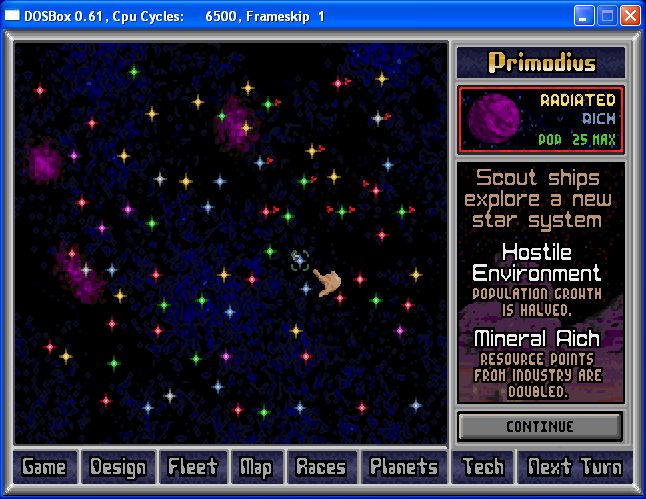
 I also start a pop-transfer of 19 from Gion to Ursa, which can then forward a like amount to Gorra after it is founded.
I also start a pop-transfer of 19 from Gion to Ursa, which can then forward a like amount to Gorra after it is founded. 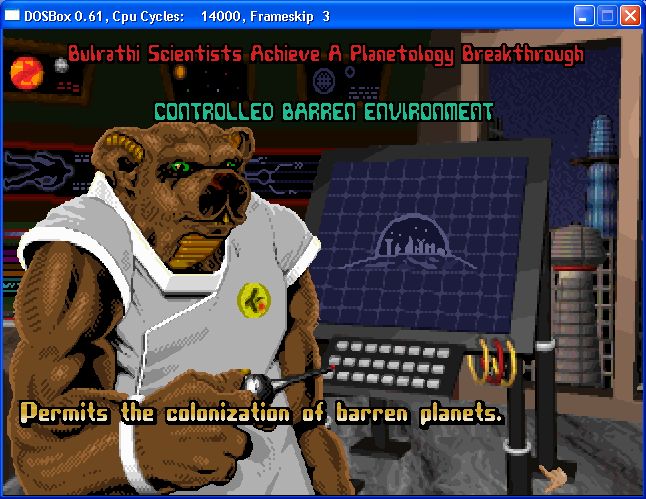
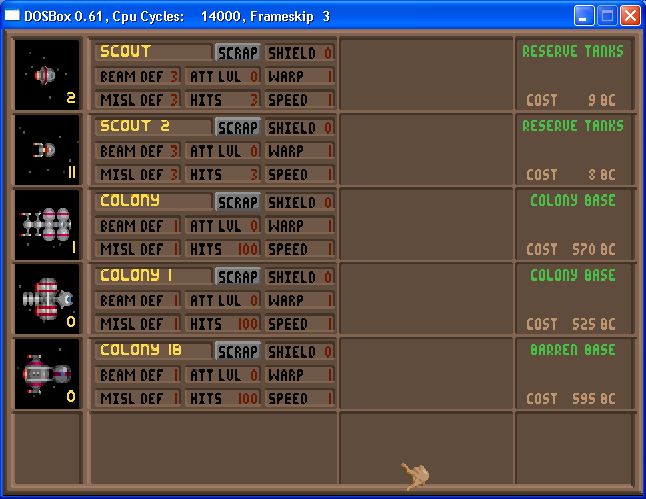
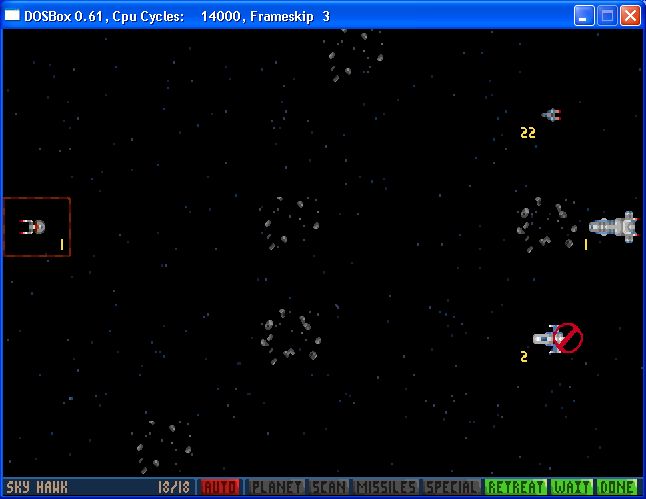
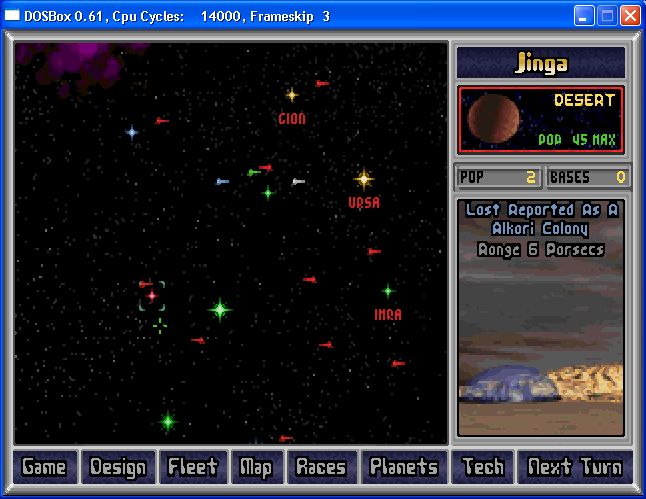
 I wouldnt want to shut research off, or reduce it much below where it is now, but thats up to the next leader. Once Gion is built up to the point where we can increase research, we need to open up the other categories, but for now my focus was on the two waste reduction techs, which will save us a lot of BC in the long run, and just minimal (10%) research into propulsion.
I wouldnt want to shut research off, or reduce it much below where it is now, but thats up to the next leader. Once Gion is built up to the point where we can increase research, we need to open up the other categories, but for now my focus was on the two waste reduction techs, which will save us a lot of BC in the long run, and just minimal (10%) research into propulsion. 


